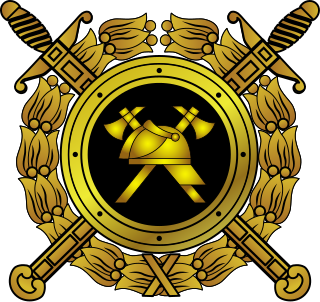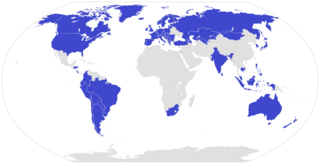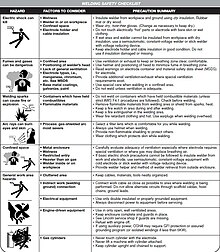Occupational noise is the amount of acoustic energy received by an employee's auditory system when they are working in the industry. Occupational noise, or industrial noise, is often a term used in occupational safety and health, as sustained exposure can cause permanent hearing damage. Occupational noise is considered an occupational hazard traditionally linked to loud industries such as ship-building, mining, railroad work, welding, and construction, but can be present in any workplace where hazardous noise is present.

Occupational hygiene is the anticipation, recognition, evaluation, control, and confirmation (ARECC) of protection from risks associated with exposures to hazards in, or arising from, the workplace that may result in injury, illness, impairment, or affect the well-being of workers and members of the community. These hazards or stressors are typically divided into the categories biological, chemical, physical, ergonomic and psychosocial. The risk of a health effect from a given stressor is a function of the hazard multiplied by the exposure to the individual or group. For chemicals, the hazard can be understood by the dose response profile most often based on toxicological studies or models. Occupational hygienists work closely with toxicologists for understanding chemical hazards, physicists for physical hazards, and physicians and microbiologists for biological hazards. Environmental and occupational hygienists are considered experts in exposure science and exposure risk management. Depending on an individual's type of job, a hygienist will apply their exposure science expertise for the protection of workers, consumers and/or communities.
GOST refers to a set of international technical standards maintained by the Euro-Asian Council for Standardization, Metrology and Certification (EASC), a regional standards organization operating under the auspices of the Commonwealth of Independent States (CIS).

An occupational hazard is a hazard experienced in the workplace. This encompasses many types of hazards, including chemical hazards, biological hazards (biohazards), psychosocial hazards, and physical hazards. In the United States, the National Institute for Occupational Safety and Health (NIOSH) conduct workplace investigations and research addressing workplace health and safety hazards resulting in guidelines. The Occupational Safety and Health Administration (OSHA) establishes enforceable standards to prevent workplace injuries and illnesses. In the EU, a similar role is taken by EU-OSHA.
Occupational medicine, previously called industrial medicine, is the branch of medicine concerned with the maintenance of health in the workplace, including prevention and treatment of diseases and injuries, with secondary objectives of maintaining and increasing productivity and social adjustment in the workplace.

Russian State Fire Service is the highest fire service body of Russian Federation. A part of the Ministry of Emergency Situations since 2001, the State Fire Service is divided into the Federal Fire Service and the Fire Service of the Federal subjects of Russia.
In common with most of Europe and North America, Australian State Parliaments have responded to workplace illness, injury, and death by enacting legislation regulating workplace hazards. Until the 1970s and 80s, these standards were generally detailed and technical, focusing mainly on prescriptive measures such as specifying machinery guarding measures to be adopted to prevent injury to workers operating dangerous machinery. Beginning in 2008, state and federal regulations were harmonised, giving greater clarity and consistency in the legislation in effect in the various states.
Optical radiation is part of the electromagnetic spectrum. It is a type of non-ionising radiation (NIR), with electromagnetic fields (EMFs).

Occupational safety and health (OSH) or occupational health and safety (OHS), also known simply as occupational health or occupational safety, is a multidisciplinary field concerned with the safety, health, and welfare of people at work. These terms also refer to the goals of this field, so their use in the sense of this article was originally an abbreviation of occupational safety and health program/department etc. OSH is related to the fields of occupational medicine and occupational hygiene.

ISO 45001 is an International Organization for Standardization (ISO) standard for management systems of occupational health and safety (OHS), published in March 2018. The goal of ISO 45001 is the reduction of occupational injuries and diseases, including promoting and protecting physical and mental health.

A respirator cartridge or canister is a type of filter that removes gases, volatile organic compounds (VOCs), and other vapors from air through adsorption, absorption, or chemisorption. It is one of two basic types of filters used by air-purifying respirators. The other is a mechanical filter, which removes only particulates. Hybrid filters combine the two.
A psychosocial hazard or work stressor is any occupational hazard related to the way work is designed, organized and managed, as well as the economic and social contexts of work. Unlike the other three categories of occupational hazard, they do not arise from a physical substance, object, or hazardous energy.
Electrical safety is a system of organizational measures and technical means to prevent harmful and dangerous effects on workers from electric current, arcing, electromagnetic fields and static electricity.

A hearing protection device, also known as a HPD, is an ear protection device worn in or over the ears while exposed to hazardous noise and provide hearing protection to help prevent noise-induced hearing loss. HPDs reduce the level of the noise entering the ear. HPDs can also protect against other effects of noise exposure such as tinnitus and hyperacusis. There are many different types of HPDs available for use, including earmuffs, earplugs, electronic hearing protection devices, and semi-insert devices.

Workplace robotics safety is an aspect of occupational safety and health when robots are used in the workplace. This includes traditional industrial robots as well as emerging technologies such as drone aircraft and wearable robotic exoskeletons. Types of accidents include collisions, crushing, and injuries from mechanical parts. Hazard controls include physical barriers, good work practices, and proper maintenance.

Road signs in Kazakhstan are similar to the road sign system of other post-Soviet states that ensure that transport vehicles move safely and orderly, as well as to inform the participants of traffic built-in graphic icons. These icons are governed by the Vienna Convention on Road Traffic and Vienna Convention on Road Signs and Signals. Road signs are regulated by the СТ РК 1125-2021 standard.

Road signs in Russia are governed by the traffic rules approved by the Decree of the Government of the Russian Federation No. 1090 of 23 October 1993 “On the Rules of the Road”, Appendix 1 “Road Signs”. They are regulated by the ГОСТ Р 52289-2019 and ГОСТ Р 52290-2004 standards determining the rules for the use and production of road signs. The vast majority of road signs used in Russia were in the preceding Soviet standard ГОСТ 10807-78, which was introduced in the Soviet Union on January 1, 1980 before its dissolution in 1991 and is no longer valid in Russia since January 1, 2006 after it was replaced by the modern standard ГОСТ Р 52290-2004 for road signs. Road signs generally conform to the Vienna Convention on Road Signs and Signals. Similar road signs are also used in other post-Soviet states.
Michael Harry Repacholi is an Australian biophysicist and radiation protection expert. He is one of the pioneer scientists and foremost authorities in Radiobiology in the world, including radiation protection standards for ionizing radiation and non-ionizing radiation across the electromagnetic spectrum. He was one of the founders and past presidents of the International Commission on Non-Ionizing Radiation Protection (ICNIRP) and founder and director of several projects in the World Health Organization, including the International Electromagnetic Fields (EMF) Project. Repacholi was also active in the study of the health consequences of the Chernobyl accident in the nuclear reactor, in Ukraine.

The Chess World Cup 2021 was a 206-player single-elimination chess tournament that took place in Sochi, Russia, beginning 12 July and ending 6 August 2021. It was the 9th edition of the Chess World Cup. The winner of this tournament was the Polish grandmaster Jan-Krzysztof Duda, who won without losing any games either in classical chess or in the rapid tiebreakers.
The road signs in the post-Soviet countries Armenia, Azerbaijan, Belarus, Estonia, Georgia, Kazakhstan, Kyrgyzstan, Latvia, Lithuania, Moldova, Russia, Tajikistan, Turkmenistan, Ukraine and Uzbekistan are largely similar to the Soviet road sign system, as these countries were part of the Soviet Union. However, in some countries of the former USSR, some road signs may look different from the Soviet ones. The Soviet Union was a signatory to the 1968 Vienna Convention on Road Signs and Signals. After the dissolution of the Soviet Union in 1991, each of the 15 post-Soviet states adopted its own road sign standard. Many of them use road sign systems that inherited the road sign system used in the Soviet Union before 1991, but with some modifications, except for Estonia and Latvia that use completely different road sign systems. Estonia and Latvia have their own road sign systems, which are very different from the Soviet one. Road signs in Armenia, Azerbaijan, Belarus, Estonia, Georgia, Kazakhstan, Kyrgyzstan, Latvia, Lithuania, Moldova, Russia, Tajikistan, Turkmenistan, Ukraine and Uzbekistan comply with the Vienna Convention on Road Signs and Signals as well as most European countries. Road signs of the post-Soviet countries may have road signs that are not found in other post-Soviet countries.


































